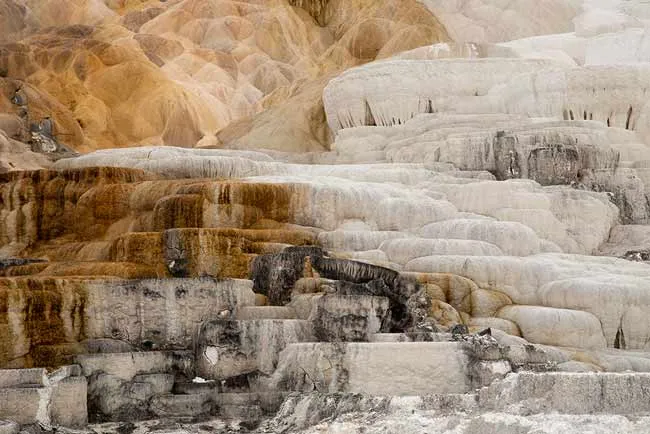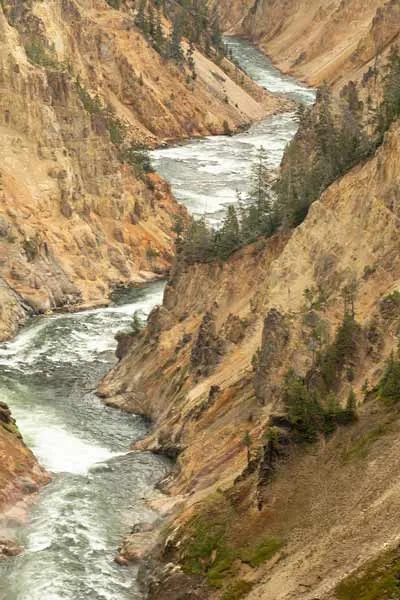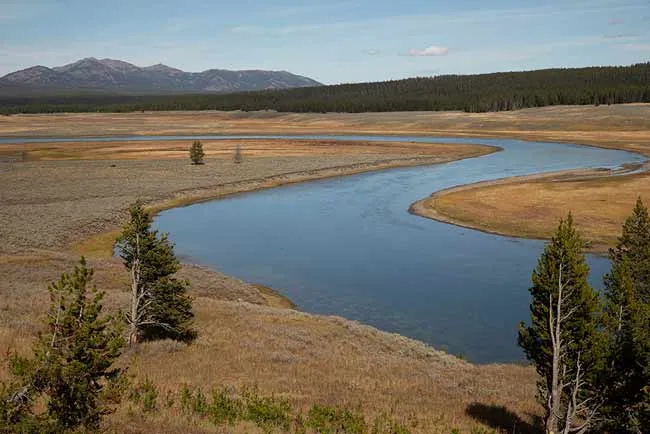Yellowstone, a jewel of America, is more than just a national park; it’s a living geological laboratory where visitors can witness the extraordinary power of the Earth firsthand. Situated atop an active supervolcano, Yellowstone is a geothermal paradise with countless geysers, hot springs, mud pots, and fumaroles. This article will guide you through how to explore the geology and volcanoes of Yellowstone, turning your trip into a fascinating scientific adventure. Together, we will decode the mysteries hidden beneath the park’s pristine beauty, from the history of supervolcano formation to the incredible geothermal phenomena, equipping you with the knowledge needed to explore Yellowstone to its fullest.
Discovering Yellowstone’s Geology and Volcanoes: A Journey to the Supervolcano’s Heart
1. Yellowstone Geology Overview: Supervolcano Awakening
Yellowstone is not just a national park with stunning landscapes, but also the heart of a colossal supervolcano that is still active. The national park is located on the Yellowstone Plateau, part of the vast Rocky Mountains. The unique terrain here is the result of millions of years of geological activity, especially catastrophic volcanic eruptions.
The Yellowstone Supervolcano is one of the few active supervolcanoes in the world. It was formed by a volcanic hotspot deep within the Earth’s mantle. This hotspot is where molten magma rises near the surface, causing volcanic activity that has lasted for millions of years. As the North American tectonic plate moved over this hotspot, it created a series of massive volcanic eruptions, forming the Yellowstone volcanic track we see today.
The three largest supereruptions at Yellowstone occurred 2.1 million years ago, 1.3 million years ago, and 640,000 years ago. The most recent eruption, 640,000 years ago, created the Yellowstone Caldera, a giant basin approximately 55 x 85 km, covering a large part of the current park area. This caldera is one of the largest volcanic calderas in the world, and it is a powerful testament to the destructive and constructive power of nature.
Today, even without major eruptions, Yellowstone is still “awake” with thousands of different geothermal features, from the world-famous Old Faithful geyser to brightly colored hot springs and bubbling mud pots. These phenomena are evidence that magma still exists underground, continuing to heat groundwater and create a complex and unique geothermal system. To delve deeper into Yellowstone’s geology, visitors can start by exploring the geothermal areas, where volcanic power is most clearly displayed.

2. Geothermal Areas: Evidence of Volcanic Power
The geothermal areas in Yellowstone are must-see destinations for anyone wanting to learn about the geology and volcanoes here. They are windows into the Earth’s interior, allowing us to directly observe ongoing geothermal processes. Yellowstone concentrates about half of the world’s geysers and hot springs, creating an incredibly diverse and vibrant geothermal landscape.
Geysers are among the most impressive geothermal phenomena. They are formed when groundwater is heated by magma underground, builds up pressure, and erupts into the air periodically. Old Faithful is the most famous geyser in Yellowstone, and perhaps in the world, with its regular and powerful eruptions, attracting millions of visitors each year. However, Yellowstone has hundreds of other geysers, each with its own unique beauty and characteristics. Steamboat Geyser in Norris Geyser Basin is the tallest geyser in the world, capable of erupting hot water columns up to 90 meters high, but its eruption times are very unpredictable.
Hot Springs are geothermal pools heated by heat from the Earth’s interior. They can reach very high temperatures, even boiling. The vibrant colors of hot springs are due to the growth of thermophiles, microorganisms capable of living in high-temperature environments. Grand Prismatic Spring in Midway Geyser Basin is the largest hot spring in Yellowstone and the third largest in the world, famous for its brilliant rainbow colors, created by different layers of microorganisms thriving at different temperatures.
Mud Pots are bubbling pools of mud, formed when hot water dissolves surrounding rock, creating mud and gas. Mud pots are usually gray or brown in color, and sometimes have a distinctive sulfur smell. Fountain Paint Pot is a popular area with many diverse mud pots, from thin gray mud pots to thick, pink or cream-colored mud pots.
Fumaroles are vents that release steam and hot gases from the Earth’s interior. They often appear in areas with strong volcanic activity. Fumaroles in Yellowstone typically emit steam, carbon dioxide, hydrogen sulfide, and other gases, creating white plumes rising from the ground.
To explore the geothermal areas in Yellowstone safely and effectively, visitors should follow designated boardwalks and adhere to warning signs. Here are some prominent geothermal areas you should not miss:
- Mammoth Hot Springs: Famous for its white travertine terraces, formed by the deposition of calcium carbonate from hot spring water. Explore Palette Spring and Liberty Cap to admire the unique beauty of this location.
- Norris Geyser Basin: The hottest and most dynamic geothermal area in Yellowstone. Here you can find Steamboat Geyser, Echinus Geyser, and Porcelain Basin, with diverse landscapes ranging from emerald-colored acidic pools to barren lands covered in steam.
- Midway Geyser Basin: Home to Grand Prismatic Spring and Excelsior Geyser, two of the largest and most beautiful geothermal wonders in Yellowstone.
- Upper Geyser Basin: The center of geysers in Yellowstone, with Old Faithful as the brightest star. But don’t miss the opportunity to explore Morning Glory Pool, Castle Geyser, and many other geysers in this area.
- Fountain Paint Pot: An area concentrated with many mud pots and fumaroles, offering a unique and diverse geothermal exploration experience.

3. Yellowstone Canyon: A Deep Cut into Geological History
The Grand Canyon of the Yellowstone is not only a magnificent landscape but also a deep cut into the geological history of the park. The canyon was formed by the Yellowstone River, but its formation process is linked to volcanic and geothermal activity.
About 600,000 years ago, after the supereruption that created the Yellowstone Caldera, a large amount of volcanic ash and rock covered this area. Under the influence of heat and hot water from geothermal sources, these layers of ash and volcanic rock were transformed into rhyolite, a volcanic rock with a distinctive yellow color. Then, the Yellowstone River began to erode this soft rhyolite rock, creating the deep and wide canyon we see today.
The vibrant colors of the canyon walls, from yellow, orange, red to white, are due to the hydrothermal alteration of the rhyolite rock. Hot water and steam from underground seeped through the rock, dissolving and depositing different minerals, creating diverse and eye-catching color bands.
Two large waterfalls, Upper Falls and Lower Falls, cascading into the canyon, further enhance the majestic beauty and erosive power of the Yellowstone River. Lower Falls, with a height of nearly 94 meters, is one of the tallest waterfalls in North America.
To explore the Yellowstone Canyon, visitors can hike on the Rim Trails on both the North and South Rims. North Rim Trail and South Rim Trail offer many stunning viewpoints, such as Artist Point, Inspiration Point, and Lookout Point, allowing you to admire panoramic views of the canyon and waterfalls from different angles.
The Canyon Village Visitor Education Center is also an ideal place to learn more about the geology of Yellowstone Canyon, its formation process, and the natural factors that created this unique landscape.

4. Yellowstone Lake: Witness to a Volcanic Eruption
Yellowstone Lake is the largest freshwater lake above 2,000 meters in North America. Remarkably, this lake is located entirely within the Yellowstone Caldera, making it one of the largest caldera lakes in the world.
Yellowstone Lake was formed after the supereruption 640,000 years ago. This eruption created the caldera, and then the caldera gradually filled with rainwater and snowmelt, forming Yellowstone Lake.
The bottom of Yellowstone Lake is still geothermally active. Scientists have discovered hundreds of fumaroles and hot springs on the lakebed, indicating that magma is still present near the surface. The water temperature in some areas of the lakebed can reach over 100 degrees Celsius.
Along the shores of Yellowstone Lake, there are many other geothermal areas, such as West Thumb Geyser Basin, a small geothermal area located right on the lake shore, with many unique hot springs and geysers.
Visitors can explore Yellowstone Lake by boat, join guided boat tours, or hike along the lake shore trails. Lake Butte Overlook is a great viewpoint to admire panoramic views of Yellowstone Lake from above, as well as the surrounding mountain ranges.

5. Current and Future Geological Activity
Yellowstone is not just an ancient geological relic but also an active geological system. Scientists continuously monitor volcanic and seismic activity at Yellowstone to better understand the ongoing processes and predict future events.
Seismic activity at Yellowstone is very frequent. Thousands of small earthquakes occur each year, but most are too small for humans to feel. However, stronger earthquakes also occur occasionally, although they rarely cause significant damage.
Ground deformation is also a common phenomenon in Yellowstone. The Yellowstone Caldera is “breathing,” meaning the ground can rise or fall over time due to the movement of magma underground.
Although Yellowstone is still volcanically active, the risk of a supereruption in the near future is very low. Scientists believe the probability of a major eruption in a human lifetime is extremely small. However, Yellowstone remains a hazardous volcanic area, and smaller eruptions, such as steam explosions or ash eruptions, are still possible.
The US Geological Survey (USGS) and Yellowstone Volcano Observatory (YVO) are the organizations responsible for monitoring and studying volcanic and seismic activity at Yellowstone. They use a network of instruments, including seismometers, deformation monitors, and gas sensors, to track changes in the Yellowstone volcanic system. Information from these devices helps scientists better understand the supervolcano’s activity and issue early warnings if any unusual signs are detected.
6. How to Explore Yellowstone Geology: Information Centers and Guided Tours
To learn more about Yellowstone’s geology, visitors can take advantage of various resources and activities in the park:
- Visitor Centers: Visitor centers like Canyon Village Visitor Education Center, Old Faithful Visitor Education Center, and Grant Village Visitor Center offer exhibits, documentaries, and detailed information about Yellowstone geology, volcanic history, and geothermal phenomena.
- Ranger Programs: Participate in ranger-led hikes, talks, or presentations. These programs often focus on geological topics, helping visitors better understand the natural processes occurring in the park.
- Guided Tours: Many tour companies offer Yellowstone tours focused on geology and volcanoes. These tours often have guides who are geology experts, providing in-depth knowledge and answering visitor questions.
- Maps and Brochures: The park provides many maps and brochures about Yellowstone geology, which can be found at visitor centers or online on the National Park Service (NPS) website.
- Hiking: Many hiking trails in Yellowstone lead to areas of special geological interest. For example, Fairy Falls Trail allows you to view Grand Prismatic Spring from above, Mystic Falls Trail passes through the Biscuit Basin area with many hot springs and geysers, and Uncle Tom’s Trail leads to the bottom of Yellowstone Canyon, allowing you to observe the rock layers and waterfalls up close.
Conclusion: Yellowstone – A Living Geological Laboratory
Yellowstone is not only a wonderful tourist destination but also a living geological laboratory, where visitors can explore and learn about the extraordinary power of nature. From the supervolcano hidden beneath the surface to the incredible geothermal phenomena above, Yellowstone offers a unique and unforgettable geological exploration experience. Come to Yellowstone, immerse yourself in the pristine wilderness, and discover the geological mysteries that await you!